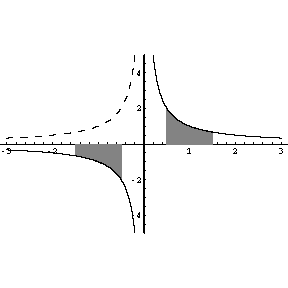Excellent question, answered (again) belatedly. Let's think about
what we mean by
int
ab(1/
x)
dx.
The graph of
f(
x)=1/
x is shown below, with two
possible areas shaded. (Ignore the dashed curve for the moment.)

Let's think about the area given by the right-most shaded region.
This is, ignoring for the moment the issue of the absolute value
(because all values of
x are positive),
int0.51.5(1/x)dx
= ln(1.5) - ln(.5)
= ln(1.5/.5) = ln(3)
(where we have used in the last line fun rules of logs to intrigue the
intrigue-able). Clearly the left-most shaded region must have area
equal to the negative of this, namely, -ln(3). How could we find
this?
Notice that the area we want is the negative of the area under the
graph of 1/(-x), the curve shown as the dashed curve above.
This would be
-int-1.5-0.5(1/(-x))dx
=
int-1.5-0.5(-1)(1/(-x))dx.
Next notice that
(d/dx)(ln(-x))=(1/(-x))(-1),
which is the integrand in this equation. Thus,
int-1.5-0.5-(1/(-x))dx
=
ln(-x)|-1.5-0.5
= ln(0.5) - ln(1.5) = ln(0.5/1.5)
= ln(1/3) = ln(3-1) = -ln(3)
Of course, this is a bit sneaky, because we rewrote the integrand
taking advantage of the fact that we knew we had to worry about what
happened when x<0. However, what we showed when we took the
derivative of ln(-x) is that (for x<0) ln(-x)
is in fact an antiderivative of 1/x. (Why is this? We showed
that it is an antiderivative of (-1)(1/(-x)), which is the same
thing.) Of course, for x<0,
-x = |x|,
so
ln(-x) = ln(|x|),
while if
x>0 we can certainly also say
ln(x) = ln(|x|).
Therefore we've confirmed that the antiderivative of
1/
x is ln(|
x|) whether
x is positive or
negative. Further, because ln(
x) isn't defined for
x<0,
we have to use the absolute value for this case.
We can also do this integral through a sneaky substitution: The
integral is
int-1.5-0.5(1/x)dx.
Because we know that we might run into trouble with
x<0
(this is 20/20 hindsight), let's make the substitution
w=-
x to see if that dodges the problem. With this
w,
dw=-
dx, so the integral becomes
int1.50.5(1/(-w))(-dw)
=
int1.50.5(1/w)dw.
(be sure you see why the limits on the integral changed). To quickly
finish the calulation, we can reverse the limits of integration and get
-int0.51.5(1/w)dw
=
-(ln(1.5) - ln(0.5)) = -ln(3).
All around, a really neat problem!
